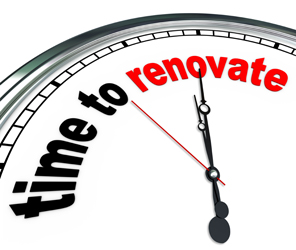Be Aware of Mold During Any Renovation Project!
In her blog, Blindsided By Mold: A True Story About A Bathroom Renovation Gone Bad—So Very, Very Bad, Trish Holder documented her battle with mold that resulted directly from a bathroom renovation project. As opposed to hiring a contractor with experience and a solid understanding of the potential risks caused by mold, she chose to hire her friend, who was a contractor.
The contractor renovated her bathroom, but did not install the shower liner and tile properly. The end result was moisture intrusion that led to a significant mold infestation that took two months and resulted in 10s of thousands of dollars worth of damage.
Trish was lucky because the contractor took full responsibility for the problem and paid for all the mold removal and reconstruction. This is a best case scenario!
But what if the contractor you hired caused the mold problem and did not pay to fix it? Then what?
The key to avoiding this type of problem is to do your due diligence when you hire a contractor. Get references, check their BBB record, find out how much experience they have, talk to other home owners who used their services, etc. Do your homework. In other words, don’t just hire the cheapest option, but the best option that can help you avoid a potential moldy nightmare!
The best option when hiring a contractor is to work with a company that has prior experience with mold testing, mold removal, and IAQ testing because they know how to prevent mold from spreading. There are many contractors, like Mold B Gone, that not only specialize in mold, but also reconstruction and renovations.
The remainder of this article will answer these three questions:
- Why could I have mold in my home?
- What should I do if I find mold during the renovation project?
- What can I do to prevent future mold problems?
Why Could I Have Mold In My Home?
According to some experts, mold is present in up to 60% of the homes in the United States.
For this reason, D.S. Berenson, an attorney with the Washington firm Johanson Berenson, stated the following:
“Mold should be treated by contractors with respect. It’s not a fire drill or a joke. The situation is no different than when a contractor encounters some other variable (asbestos, radon, lead paint) that he isn’t equipped to handle.”
The key ingredient mold needs to grow and thrive is moisture.
Unfortunately, there are ample sources of moisture in a home that could be caused by water damage from leaky pipes, a leaky roof, shower walls with cracks, foundations that allow moisture intrusion, excessive humidity of 70%, past flooding issues, etc.
People have this mis-conception that mold is only found in old homes. However, this is not true.
A disturbing trend is the fact that mold is often found in newer homes. The prevalence of mold in newer homes is directly related to the trend towards building energy efficient homes, which prevents drafts and cross-ventilation. Sealing homes tight with vapor barriers, traps moisture. The other problem is builders tend to use cheaper materials to build homes, opting for OSB, which acts like a sponge when it gets wet, contributing to mold growth.
Since mold could be in 6 out of 10 homes, if you are considering a renovation or remodeling project, then it is very important that you understand what to do if you find mold…
What Should I Do If I Find Mold During The Renovation Project?
Many Do It Yourselfers that take on home renovation projects like interior painting, kitchen remodeling, bathroom renovation, floor replacement, and window replacement, rarely understand the risks of mold. Even if they do, they may not know how to ensure that the mold contamination is prevented from spreading throughout the home.
The biggest risk you encounter by doing the renovation yourself or hiring an inexperienced contractor is cross contamination, meaning the spores spread throughout the home. You need to contain the area where you find mold to prevent this from happening. Most importantly, prevent the spores from entering your HVAC system, to prevent contamination of the duct system, spreading spores into every area of the home.
With this in mind, if you find mold during the tear down process of drywall, removal of carpet or flooring, and/or during the removal of bathroom fixtures such as the tub, shower liner, etc. your first priority is to determine the extent of the problem. If you are not sure how to do this, call a professional mold inspector.
Before you do anything, determine what the underlying moisture issue is because mold only grows when there is moisture present. Further renovations and reconstruction should only commence once the underlying cause of the moisture problem, i.e. the moisture source is identified and fixed. Failure to do this will result in future costly headaches if this step is not taken.
For mold problems under 50 square feet, like a few patches on a wall, then you can likely manage the mold problem yourself.
If you are seriously considering removing the mold yourself, contact a professional for an educated assessment and further advice on how to proceed.
It is worth getting a formal mold inspection and/or air quality test on your home before you decide to remove any mold yourself. It is better to be cautious, particularly when you are dealing with mold because exposure can cause health issues.
If you decide to remove the mold yourself make sure you keep these tips in mind:
- Prevent cross contamination by setting up a containment, using poly you can get from your local hardware store. Also, be sure to close off any vents in the area of mold removal.
- Understand that mold can be toxic, so be safe. Wear protective googles, rubber gloves, a dust mask, and protective clothing, preferably a tyvek suit.
- Don’t just spray the mold contaminated materials with bleach, praying your mold problem will go away. Bleach is not effective on porous materials, so it is best to throw out contaminated ceiling tiles, carpet, underpad, drywall, etc. Double bag and dispose of mold contaminated materials properly.
- Mold contamination on non-porous materials can be scrubbed or brushed off. You may also find some biocides and fungicides at your local hardware store or online that could be effective.
- To prevent mold spores from becoming airborne use a HEPA vacuum.
If you encounter mold, under no circumstances should you ignore it. Address your mold problem to prevent:
- Your property value from declining. Understand that as long as the conditions are present for mold growth, it will thrive and grow. Mold is like a parasite or cancer and will continue to feed on your home, causing wood to rot, and future structural integrity issues.
- Health issues. There is a growing body of research and literature pointing to the fact that mold causes health problems, like asthma and chronic sinusitis. Mold is a particular concern for mold sensitized individuals that have the genetic predisposition to Chronic Inflammatory Response Syndrome.
What Can I Do To Prevent Future Mold Problems?
To prevent future mold issues here are 10 tips:
- To prevent moisture intrusion, fix cracked foundations, damaged roofs, warped window panes and/or eroding tile grout.
- Ensure vapour barriers and insulation are in good condition and properly placed.
- If there is a moisture event such as a flood or major leak, dry the materials as soon as possible. To prevent mold growth, wet materials need to be dried or removed within 24 to 48 hours.
- Monitor humidity levels with a hygrometer. Humidity levels should be maintained between 30 percent to 50 percent.
- Reduce indoor mold spore counts with cross-ventilation by opening windows and doors to allow fresh air in.
- Properly seal windows, insulate cold water pipes and air conditioning vents to prevent condensation-related moisture issues.
- Clean and repair eaves troughs and downspouts regularly so that water flows away from the foundation of your home.
- If your home or basement has excessive humidity, use a dehumidifier, and consider water proofing your basement, particularly if it is susceptible to moisture intrusion.
- Use your senses to monitor areas of your home that are most likely to develop mold: bathrooms, kitchens, basements and attics. Visual clues likes surface discoloration and musty, earthy smells are clues that you may have mold growing in these areas.
- When cooking or showering turn on the kitchen and bathroom fans to prevent excess moisture, humidity and condensation issues. Ideally run the fans for 30 to 60 minutes.
Questions? We are mold inspection, detection, and removal experts. Call us, 678-697-6267, or contact us via e-mail. We look forward to serving you! 🙂
Is #Mold A Concern During Renovations?: Home improvement is an American tradition. But, did you know that 6 out of 10…
Posted by Mold-B-Gone Remediation, LLC on Tuesday, October 6, 2015
Is #Mold A Concern During Renovations? PLS RT http://t.co/2pO9Hsoi3I pic.twitter.com/RGyfSCMqeV
— Mold B Gone (@moldbgonega) October 6, 2015


